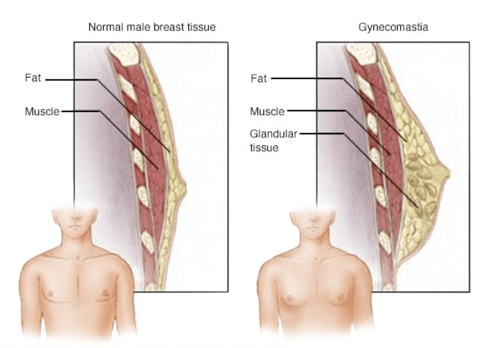
Gynecomastia is the enlargement of glandular tissue in the male breast, often resulting in a more pronounced chest appearance. This condition is caused by an imbalance between estrogen and androgen levels and can affect males of all ages. It commonly occurs during puberty or later in life, particularly in middle-aged and older men.
Gynecomastia is most prevalent during three age periods: neonatal, during puberty, and in older adults. While pubertal gynecomastia resolves in approximately 90% of cases within two years, persistent cases can have a lasting physical and psychological impact.

How Severe is Gynecomastia?
Gynecomastia varies in severity. Below is a grading scale used by medical professionals to classify the condition:

- Grade 1: Small localized tissue growth around the nipple.
- Grade 2: Moderate breast enlargement without excess skin.
- Grade 3: Significant breast enlargement with excess skin.
- Grade 4: Severe breast enlargement resembling a female breast.
What Can You Do About Gynecomastia?
Diet & Exercise
For those dealing with pseudogynecomastia, where excess chest fat mimics gynecomastia, maintaining a healthy weight can help reduce the prominence of the chest. Exercise, particularly strength training and cardio, plays a crucial role in overall fat loss.
Recommended Exercises:
- Chest workouts: push-ups, bench presses, and dumbbell flys
- Cardio: running, cycling, and swimming to reduce overall body fat
- Core training: planks and ab workouts to improve body composition
Learn more about the benefits of exercise for gynecomastia sufferers and how a structured workout plan can help.
Compression Garments
For those seeking an immediate solution, a compression vest can help flatten the chest and improve confidence. Many men find that shapewear provides a discreet and effective way to feel more comfortable in fitted clothing.
Hiding Gynecomastia
Styling choices can make a big difference in minimizing the appearance of gynecomastia. Opting for structured fabrics and darker colors can help disguise chest prominence. For practical tips, check out our gynecomastia clothing guide.
Surgical Treatment
For those considering permanent solutions, gynecomastia surgery may be an option. The procedure typically involves:
- Liposuction – removes excess fat from the chest.
- Glandular Excision – removes the underlying glandular tissue that causes gynecomastia.
Before opting for surgery, it’s important to weigh the risks. Read Should You Consider Gynecomastia Surgery? to learn more about potential outcomes and costs.
Can Gynecomastia Go Away on Its Own?
Whether gynecomastia disappears naturally depends on its cause:
- If gynecomastia occurs during puberty, there is a high chance it will resolve within 6 months to 2 years.
- If caused by medications, stopping the drug may help, but glandular tissue that has already developed may not shrink.
- If gynecomastia has persisted for over a year, it is unlikely to resolve without medical intervention.
If you're wondering about the likelihood of natural resolution, read Does Gynecomastia Go Away on Its Own?.
Final Thoughts
Gynecomastia is a common condition, but with the right approach, it can be managed effectively. Whether through lifestyle changes, compression garments, or medical intervention, options are available to help you feel more confident.
If you're looking for an immediate solution, a compression vest offers a simple and effective way to minimize chest prominence.
